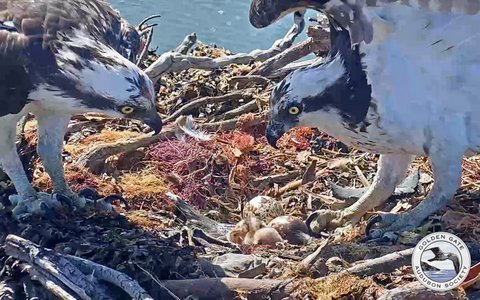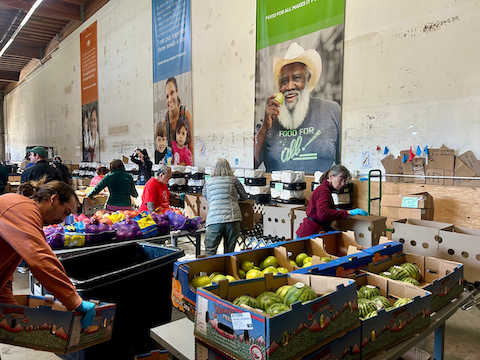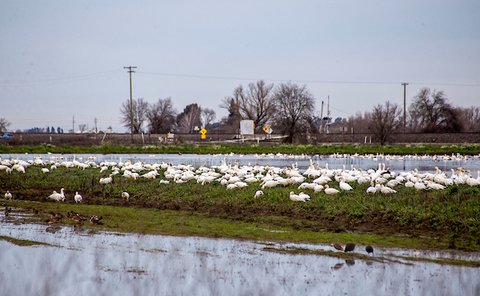
19 Jun From Shipyard to Sanctuary: How Ospreys Reclaimed Whirley Crane

Ospreys Richmond and Rosie watch as their eggs begin to hatch in May 2022. (Golden Gate Audubon Society via Bay City News)
By Jonathan Hale
Once, it was a key part of Richmond’s contribution to the war effort. Now, it’s for the birds — literally.
At the height of Richmond’s WWII-era industrial heyday, the hulking iron skeleton of Kaiser Shipyard No. 1’s Whirley Crane loomed over the city skyline. Called a “Whirley Crane” because of its ability to rotate a full 360 degrees, the monolithic apparatus was instrumental in hoisting, lowering and moving prefabricated ship parts into position for assembly. For decades, the crane was a poignant symbol of Richmond grit and industriousness.
Now, the rusting frame of the Whirley Crane is the nesting site for a mating pair of ospreys named Richmond and Rosie. They live atop the crane’s vacant cabin in a nest made from branches, reeds and bits of flotsam. The duo take turns hunting fish, fending off other birds, and nurturing their eggs.
Ospreys are a species of bird of prey, sometimes referred to as sea hawks, that feed almost entirely on fish.
They are large raptors, possessing wingspans of 5 to 6 feet, according to the National Audubon Society. They are notable for their coloration, with black wings, a white underbelly and a distinctive band of dark feathers across their face. Adaptations such as rounded, hook-like claws to latch onto elusive prey and precise vision make ospreys extremely successful fish hunters.
Ospreys’ unmistakable appearance and hunting prowess have made them a symbol of awe and admiration for thousands of years. Yet during the mid-20th century, ospreys were pushed to the brink of extinction due to the widespread use of the insecticide DDT.
The potent chemical was applied in agricultural and public health settings to ward off insects from crops and to minimize the spread of diseases such as malaria. Part of what made DDT so effective — and deadly — was the fact that it would remain in an environment long after its introduction.
This meant that while DDT was an extremely powerful insect repellant, the chemical would work its way up the food chain without breaking down. When birds of prey such as ospreys consumed DDT-laden prey, the consequences for wild populations were disastrous.
The harmful properties of DDT resulted in ospreys laying eggs with thin and fragile shells. Osprey populations plummeted.
According to the Golden Gate Audubon Society, ospreys had not been known to nest directly along San Francisco Bay prior to the 1990s.
But after DDT was banned in the United States in 1972, birds of prey slowly started to rebound. As ospreys have clawed their way back from the brink of extinction, they have taken advantage of cell towers, power poles and other human-made structures to build their nests. For entrepreneurial ospreys flying around San Francisco Bay, the Whirley Crane became prime nesting real estate.
Starting in 2010, ospreys staked out the site as a potential location to settle down. Citizen scientist and Golden Gate Raptor Observatory volunteer Tony Brake has helped lead efforts “ to find and monitor all osprey nests on the edge of San Francisco Bay since 2013,” according to Golden Gate Audubon.
Following a series of brief or unsuccessful stays by other ospreys, Richmond and Rosie arrived together at the Whirley Crane in 2017. In a high-profile effort spearheaded by the Golden Gate Audubon Society, nest cameras were installed to monitor the pair as they moved into their new home.
Ospreys usually are monogamous and mate for life, raising one to three chicks together each year. Occasionally, Rosie will migrate south, always returning home to her partner to mate and lay eggs.
Nurturing chicks is no easy task. Nesting season begins at the tail end of winter and lasts through around August. The parents take turns incubating and protecting the eggs for over a month until they hatch.
Once the chicks have come out of their shells, it may take as long as 55 days for the baby birds to take flight for the first time. Despite their parents’ best efforts, fledgling ospreys sometimes don’t make it out of the nest.
Nonetheless, Richmond and Rosie have successfully hatched and raised 12 chicks to adulthood. Some of their offspring have remained close to home, nesting and mating elsewhere in the Bay Area. Including Richmond and Rosie’s children, ospreys have made a remarkable recovery in the region with 48 active nests observed in 2022.
If you tune into the Golden Gate Audubon Society’s nesting camera this nesting season, you can watch Richmond and Rosie taking care of two eggs. Before a backdrop of the San Francisco skyline, the pair take turns incubating their eggs, hunting and maintaining the nest.
Because ospreys have adapted so easily to coexisting with humans, researchers have proposed using them as a “sentinel species” to monitor the prevalence of environmental contaminants.
By studying osprey nesting patterns, eggs and carcasses, scientists are able to gain valuable insight into the pollutants that threaten wild animals living near people. Their presence near humans allows us not only to learn about ospreys but about ourselves.
As Richmond and Rosie prepare to hatch this season’s eggs, the pair remind us that it is possible to coexist with nature in the densely populated Bay Area.
And just as the Whirley Crane once served as an icon of the city of Richmond’s resilience and determination, so too do its current inhabitants.
For the Record: The file photo at the top of this story was originally published with a caption saying that Rosie and Richmond “welcomed their newest chicks this week.” That information was from May 2022. It has been removed from this story.






No Comments